Grasse 作者: 来源: 发布时间:2021-09-26
I.Population and Area
Region: Provence-Alpes-Côte d'Azur
Department: Alpes-Maritimes
Code Insee : 06069
Code postal : 06130 or 06520
Total Area: 44.44km²
Population in 2017: 50 396
Population Density: 1134 /km²
Location: The altitude of the city hall of Grasse is approximately 300 meters. Its surface area is 44.44 km². The latitude and longitude of Villages are 43.659 degrees North and 6.923 degrees East. The towns and villages near Grasse are: Cabris (06530) at 3.91 km, Peymeinade (06530) at 4.02 km, Châteauneuf-Grasse (06740) at 4.53 km, Opio (06650) at 4.86 km, Spéracèdes (06530) at 5.25 km.
Histogram of demographic change
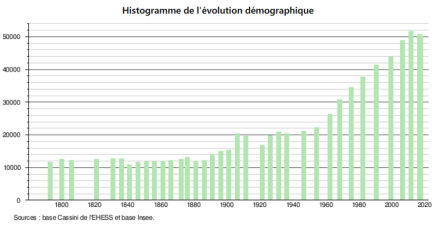
Sources :http://www.cartesfrance.fr/carte-france-ville/06069_Grasse.html
II.Natural Geography
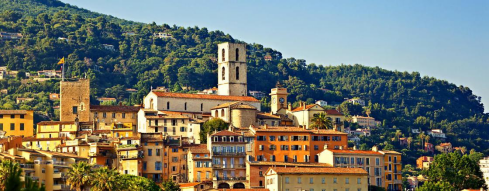
Geographical environment: Grasse, town, Alpes-Maritimes département, Provence–Alpes–Côte d’Azur région, southeastern France. It lies northwest of Cannes(15 kilometres from Cannes) and west-southwest of Nice. Situated at an elevation of 1,100–1,250 feet (330–380 metres) on a slope in a natural amphitheatre in the lower Alps, it is a resort that is visited in both summer and winter. Grasse is a breath of fresh air in a verdant setting of mountains, forests and caves. Although the fourth biggest city of the department of the Alpes-Maritime, the city and its environs are also a place for rest and a vacation.
Climat: Grasse benefits from a Mediterranean climate and a microclimate which gives it rather mild temperatures. Summers are known to be hot, almost always exceeding 25 °C or even 30 °C. The winters are rather mild and dry, regularly accompanied by snow above 500 m, particularly in the area of the Bois de la Marbrière, north of the city ; on the other hand, the total snow cover of the city is not systematic and occurs approximately every two or three times per winter, and this, over a very short period, most often around the month of February. Besides, in mid-season, precipitation appears in a violent and abundant way, which causes serious problems of rainwater flow in the streets of the old town.
Natural environment and biodiversity: The site of the Bastide Saint Antoine in Grasse conceals a park of thousand-year-old olive trees, from this place the magnificent view of the Estérel. This superbly maintained park of olive trees is the testimony of ancestral cultures. Besides, the municipality has large forest areas: a quarter of the territory is classified as a municipal nature reserve.
Transport:
(1) Traffic in the city: The city is accessible thanks to the lines of the TAM network (Transport des Alpes-Maritimes) operated by the general council: with the 500 from Nice, the 610 from Cannes (by Pégomas) or the 600 (by Mouans-Sartoux) 17. Within the city and throughout the country of Grasse, from Mougins to Saint-Auban, public transport is provided by the Sillages intercommunal syndicate.
(2) Trains: The Gare de Grasse railway station,service by the SNCF, offers connections with Cannes, Nice and Ventimiglia. A TER runs there every hour and there is an attendance of nearly 2,500 passengers per day. The counters are open at the Gare de Grasse: Monday to Saturday from 6.15 a.m. to 8.55 p.m. - Sunday and public holidays from 9.30 a.m. to 12 p.m. and 1 p.m. to 5.40 p.m.
(3) Cycling: Cycling in a town with very chaotic relief will be appreciated by seasoned cyclists and climbers. The roads (200 km of roads in all) are often very narrow and therefore little equipped with cycle paths, even if such facilities have multiplied on the main roads or the widest roads in recent years. A project to put a funicular back into service connecting the SNCF station to the city center has been abandoned (2010).
Sources :http://www.petit-patrimoine.com/fiche-petit-patrimoine.php?id_pp=06069_1
https://www.britannica.com/place/Grasse
http://www.ville-grasse.fr/transport.mob
III.Economy
Grasse Accounting income in 2018 was 5 170 040 €, or 101 € per inhabitants.
Self-financing capacity in 2018 was 7 721 650 €, or 150 € per inhabitants.
Income: According to Insee, in 2014, the inhabitants of Grasse earn on average € 2 563 net per month, or € 30 751 net per year, much higher than average income in France.
Unemployment rate: In 2016, its unemployment rate was 15.2%, which was higher than the French average of 11%.
Companies: In 2017, the total number of companies in Grasse was 4755, and there were 558 new companies.
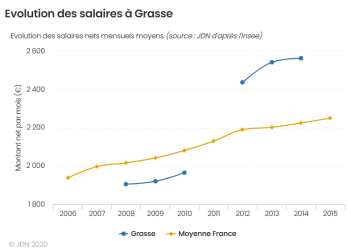
Evolution of average monthly net wages
Sources : http://www.journaldunet.com/management/ville/grasse/ville-06069/budget
IV.Industrial Characterisitics
The town has various agricultural processing industries and is noted for its candied fruit. It is also an administrative and commercial centre as well as a dormitory town for commuters to Cannes and Nice. In the 19th century, Grasse became the world perfume capital and a big tourist destination.
Perfume industry: The tanning of leather had been the city's main activity in the Middle Ages until it reached its peak in the 17th century. With the concept and then growing popularity of perfumed gloves, this period saw the birth of the perfume industry, which reigns supreme since. Today, the industry with its 30 perfume factories remains discreet but three manufacturers open their doors to you and offer free guided tours, The Parfumerie Fragonard, its historic factory and perfume shop, the Parfumerie Molinard and the Galimard Factory and Museum. The tours let you discover all the steps in perfume making, from the gathering of the flowers to the bottling, and at the end of the tour, the visitor can create and go home with her, or his, own perfume. The International Perfumery Museum (MIP), situated in the centre of Grasse, retraces the 3000 years of perfume's history in its exceptional setting and the MIP's Garden in Mouans-Sartoux is a perfume plant conservatory.
Tourism: The city comes from the perfume sector and that is ahead of tourism and services.
Candied fruit: Founded in 1949, the Confiserie Florian in the Gorges du Loup sits in a breathtaking setting beside the Loup River, in the lower hills of Grasse’s beautiful backcountry. Decorated with antique furniture from the South of France dating from the 17th and 18th centuries, both Confiserie Florian locations, Nice and Le Pont du Loup, are a blend of tradition, refinement, and taste.
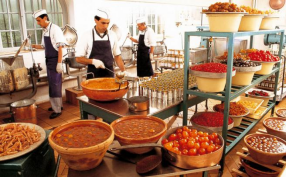
Sources: https://tourisme.paysdegrasse.fr/en/node/431
https://www.avignon-et-provence.com/tourisme-provence/grasse
V.Attractions
1.The International Perfume Museum
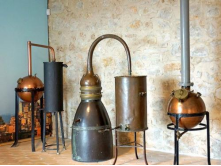
Created in 1989, the International Perfume Museum, a unique museum in the world, is located in the emblematic territory of the city of Grasse, the cradle of luxury perfumery. Dedicated to one of the most prestigious traditional French activities, the International Perfume Museum, a public establishment, labeled “Musée de France”, allows visitors to discover the history and originality of the profession of industrialists and major brands. of perfumery. True testimony to the international technical, aesthetic, social and cultural history of the tradition of the use of scents, the museum takes an anthropological approach to the history of fragrances in all its aspects - raw materials, manufacturing, industry, innovation, trade, design, uses and through very diverse forms - works of art, decorative arts, textiles, archaeological evidence, unique pieces or industrial forms.
Here, you will discover the history of perfume, this timeless accessory of seduction: through a collection of more than 50,000 objects, 2,500 of which are on display to the public, all aspects of perfumery are discussed, from raw materials to industry, design, marketing… Along with the history of perfume, the first traces of which can be found with perfume and cosmetic vases dating from 7,000 BC, and the presentation of unusual objects from various periods, flasks, organ perfumes, make-up boxes, perfume burner. It is here all the French excellence in perfumery that visitors can also discover.
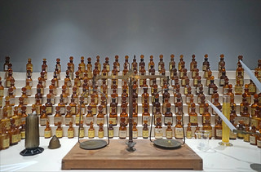
Following a Western historical chronology - Antiquity, Middle Ages, modern and contemporary periods - the museum is organized into five parts each representing a historical period and contemporary themes: elegance and classicism, magic and dynamism, frivolity and hygiene. This 21st century museum takes a look at the past, but also at the present and even foresight if one thinks of the section on the era of globalization, marketing and communication and new markets.
Website: www.museesdegrasse.com
Location: 2 Boulevard du Jeu de Ballon, 06130 Grasse, France
Source: https://www.museesdegrasse.com/presentation-du-musee-0
https://www.france-voyage.com/tourisme/musee-international-parfumerie-2637.htm
2.Parfumeries
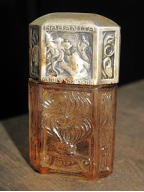
Three perfume factories offer daily tours and demonstrations, which draw in many of the region's visitors. Three of Perfume shops, Fragonard, Galimard and Molinard open their doors to the public and offer free guided tours to explain the perfume manufacturing processes. You can create your own perfume or eau de toilette there and participate in all stages of its production, from collecting flowers to bottling the perfume.
(1)The Galimard perfumery, created in 1747 by Jean de Galimard supplied the Court with ointments and perfumes. It was relaunched after the war by Gaston de Fontmichel and Joseph Roux.
Location: 73 Route de Cannes, 06130 Grasse, France
(2)Molinard perfumery presents old bottles signed Baccarat or Lalique, series of labels. The tarinology workshop allows you to create your own perfume. The Maison Molinard was founded in 1849 in Grasse. It has remained an entirely family-run business to this day, and is also one of the oldest of its kind in France after Parfumerie Galimard established in 1747. At that time, Molinard produced floral waters and Eau de Cologne. In 1860 the firm began creating new single floral fragrances from Jasmin, Rose, Mimosa and Violet in discreet, elegant bottles made of Baccarat crystal. In 1900, the company moved into an old perfume factory, where the distillery structure was designed by Gustave Eiffel and perfumery is still based there today. Molinard's first customers were wealthy foreigners from England and Russia that came to the french riviera and also bought Molinard's eau de Cologne and other floral fragrances. In 1920, the famous bottle-designer Julien Viard (1883-1938) created a number of outstanding glass flacon designs for company perfumes. 1921 the firm launched one of the first solid perfume, Concréta, a fragranced natural flower wax used directly as a perfume. During 1920's and 1930's Art-Deco interwar period the company also hired renowned glassmaker René Lalique of Lalique to design and produce a number of magnificent bottles for Molinard that are sought after collector's classic today.
Location: 60 Boulevard Victor Hugo, 06130 Grasse, France
(3)The Fragonard perfumery has been installed since 1926 in one of the oldest factories in the city. Its museum (Villa Musée Fragonard) presents rare objects that evoke the history of perfumery for more than 5,000 years.It was founded by a former Parisian notary, Eugène Fuchs, in one of the oldest factories in the city, originally built by perfumer Claude Mottet in 1841. The firm is named after the great local painter Jean Honoré Fragonard, himself the son of a master perfumer at the court. Fragonard opened its first Parisian boutique in 1936, after launching two successful perfumes. The firm also owns a free museum in Paris, the Musée du Parfum, which presents rare objects that evoke the history of perfumery for more than 5000 years.
Location: 23 Boulevard Fragonard, 06130 Grasse, France
3.Notre-Dame-du-Puy Grasse Cathedra
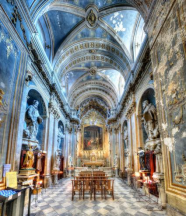
Grasse Cathedral (French: Cathédrale Notre-Dame-du-Puy de Grasse) is a 12th-century Roman Catholic church located in Grasse, France. The former cathedral is in the Romanesque architectural style, and is a national monument. It is now the church of Notre-Dame-du-Puy. It was the seat of the Bishop of Grasse. The diocese of Grasse was absorbed by the diocese of Nice under the Concordat of 1801.
The cathedral dates from the mid-13th century (the bishopric was transferred from Antibes to Grasse in 1244). The architecture is influenced by both Liguria and Lombardy (layout, decorative elements, vaulting). The main facade is simple and unassuming, reflecting the interior layout : a raised central nave and two side aisles. In the 18th century, a crypt was dug beneath the cathedral and the interior tiling and steps were redone. The central doorway became the sole entrance through the façade, reached by a double staircase, with a statue of the Virgin above it. The cathedral has six stained-glass windows and four Baillet statues representing the four Evangelists : St. Matthew, St. Mark, St. Luke, and St. John.
Location: 6 Place du Petit Puy, 06130 Grasse, France
Source: https://tourisme.paysdegrasse.fr/en/node/91
4.The Provence Art and History Museum
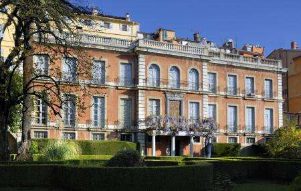
The Provence Art and History Museum is housed in an eighteenth century mansion built by one of the oldest families of medieval Provencal nobility, the Grasse family then Grasse-Cabris combined with the Clapiers.
The Provence art and history museum (M.A.H.P.) brings together, in the hotel Clapiers-Cabris, large collections devoted to both everyday life in Eastern Provence since prehistoric times, and Fine Arts and Decorative Arts from the 17th century to the first half of the 20th century.
This regional museum is the work of François Carnot (1872-1960), son of the former President of the Republic married, in Grasse, to Valentine Chiris, daughter of a perfume industrialist who was at the origin of solvent extraction. The creation of this museum quickly gathered together the local elite and a number of French and foreign donors. It is based on a large group of friends of the museum, owners of the collections, which today supports the museum's development and activities.
Based around regional archaeology and popular arts and traditions, a selection of paintings, sculpture, graphic art, furniture, ceramics, glassware, textiles, jewellery and weapons, the museum tells the history of the Eastern Provence whose traditions, firmly rooted in everyday life, favoured the emergence of strong local identities.
In this mansion, which has retained its original distribution of staterooms and private spaces, reconstructions of rooms where he would have lived and didactic exhibitions coexist harmoniously on three levels opening onto the south side, to the garden.
Location: 2 Rue Mirabeau, 06130 Grasse, France
Source: https://www.museesdegrasse.com/en/presentation-museum-0
5.The Jasmine Festival
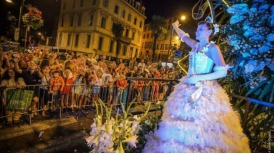
The Jasmine Festival takes place at the beginning of August. There are parades of floats, brass bands, fireworks and cultural performances around the theme of the Jasmine flower. In total, 150,000 flowers are used for the festivity. The first edition of this popular and tourist festival took place in 1946 and the principle of the parades dates from 1948.
Jasminum grandiflorum cultivated in Grasse since the middle of the 19th century gives off an unforgettable sweet, floral and fruity fragrance, wonderfully suited to the creation of the largest compositions. The picking season runs from August to October. Every day, the pickers meet in the fields and from 5 am, start to release these delicate flowers with a bewitching fragrance. It takes two hours to pick up a kilo of these little white stars that will need to be delivered to factories early in the afternoon for immediate processing.
Every year since 1946, Grasse has celebrated the iconic jasmine and paid a popular tribute to growers and designers alike, to the earth and to the final scent. By tradition, the first weekend of August opens the festivities. Everywhere in the streets, the little white flower is sublimated, like a beauty queen. The crowd flocked and expressed their joy.
Source: http://www.ville-grasse.fr/fete_du_jasmin.html
VI.History
In the 12th century Grasse was a miniature republic, but in 1227 it was taken by Raymond Bérenger, count of Provence, and from 1244 until 1790 was an episcopal see. Its Fragonard Museum, named after the 18th-century French court painter, who was born there, contains three paintings and several drawings by the master. Queen Victoria of Great Britain (reigned 1837–1901) passed several winters at Grasse.
Grasse is a Medieval town with an eventful history. It withstood Saracen raids in the 9th century and by the 12th century was an independent republic. In 1227 it came under the control of the Count of Provence, and was the Bishopric of Antibes from 1244 to 1790. In 1860 after the County of Nice became a part of France, Grasse was attached to the Alpes-Maritime.
The old town is a fascinating historic town, with many places of interest. It has the remains of 16th century ramparts, narrow streets winding between the 17th and 18th century buildings, ancient steps, arched tunnels, vaulted passageways, and large squares. The old town is a delightful place to enjoy the sunshine sitting on the terrace of one of its’ numerous bars or cafes.
Sources: https://www.gordes-village.com/en/discover,history,151,55.html
https://www.aboutfrenchproperty.com/grasse
VII.Other information
Grasse is a town of art and history(Villes et Pays d'art et d'histoire), which is an official French label awarded since 1985 by the Ministry of Culture and Communication to the municipalities or countries of France which are committed to a policy of animation and enhancement of their built, natural and industrial heritage, as well as of the architecture.
“The city of Grasse has been labeled“ 3 flowers ”since 2009 by the National Council of Cities and Villages in bloom. A satisfecit for Grasse, rich in a territory of 4444 hectares including 1543 hectares of forests and scrubland.
Sources : http://www.journaldunet.com/management/ville/grasse/ville-06069
http://www.ville-grasse.fr/ville_fleurie.mob
VIII.Contact information
Address of Grasse town hall:
Mairie de Grasse
Place du Petit-Puy
BP 1269
06131 Grasse Cedex
Phone number: 04 97 05 50 00
Fax: 04 97 05 51 51
E-mail: info@ville-grasse.fr
Website: http://www.ville-grasse.fr
Mayor : Jérôme Viaud (Mandat : 2014-2020)
Sources : http://www.cartesfrance.fr/carte-france-ville/06069_Grasse.html#mairie
